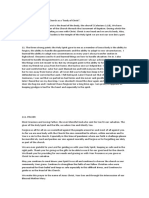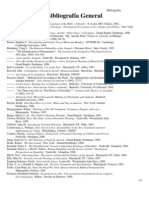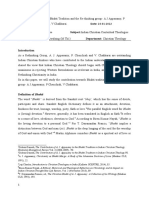The Alexandrian and Antiochene Schools of Biblical Interpretation
The Alexandrian and Antiochene Schools of Biblical Interpretation
Uploaded by
danielayoolaaboladeCopyright:
Available Formats
The Alexandrian and Antiochene Schools of Biblical Interpretation
The Alexandrian and Antiochene Schools of Biblical Interpretation
Uploaded by
danielayoolaaboladeCopyright
Available Formats
Share this document
Did you find this document useful?
Is this content inappropriate?
Copyright:
Available Formats
The Alexandrian and Antiochene Schools of Biblical Interpretation
The Alexandrian and Antiochene Schools of Biblical Interpretation
Uploaded by
danielayoolaaboladeCopyright:
Available Formats
The Alexandrian and Antiochene Schools of biblical interpretation represent two distinct
approaches to understanding and interpreting the Scriptures, each with its own theological
emphasis and hermeneutical principles. While both schools flourished in the early centuries of
Christianity, they originated in different geographical locations and developed unique perspectives
on biblical interpretation.
Alexandrian School
1. Geographical Origin: The Alexandrian School was centered in Alexandria, Egypt, a city
known for its intellectual and cultural richness. It was a hub of Hellenistic thought and
influenced by the philosophical traditions of the time.
2. Theological Emphasis: The Alexandrian School placed a strong emphasis on allegorical
and spiritual interpretation of the Scriptures. Scholars like Origen, Clement of Alexandria,
and Athanasius were associated with this school. They sought deeper spiritual meanings in
the biblical text, believing that the Scriptures had hidden, symbolic truths beyond the literal
meaning. Allegory was seen as a way to uncover these deeper spiritual insights.
3. Christological Focus: Alexandrian interpreters often focused on Christological
interpretations, seeking to find references to Christ and the deeper mysteries of the
Christian faith in the Old Testament. They believed that the Old Testament contained
typological and allegorical prefigurations of Christ and the Christian life.
Antiochene School
1. Geographical Origin: The Antiochene School was based in Antioch, a city in the eastern
part of the Roman Empire, known for its cultural diversity and commercial activity. It was
a crossroads of various cultures, including Jewish, Greek, and Roman.
2. Theological Emphasis: The Antiochene School had a more literal and historical approach
to biblical interpretation. Scholars like Theodore of Mopsuestia and John Chrysostom were
associated with this school. They focused on understanding the historical context,
grammar, and linguistic aspects of the biblical text. The literal sense of the Scriptures was
considered crucial for grasping the intended meaning.
3. Historical and Grammatical Exegesis: Antiochene interpreters emphasized historical and
grammatical exegesis, seeking to understand the original intent of the biblical authors.
They were cautious about reading too much allegory into the text and aimed to uncover the
plain, literal meaning of the Scriptures.
KEY DIFFERENCES
S/N Alexandrian School Antiochene Schoo
1 Emphasizes allegorical and spiritual Emphasizes a more literal and historical
interpretations, seeking deeper symbolic approach, focusing on the plain sense of the
meanings in the text. text.
2 Often seeks Christological meanings and While recognizing Christological themes,
allegorical prefigurations of Christ in the tends to approach the Old Testament more
Old Testament. historically and grammatically.
3 Developed in a cosmopolitan and Developed in a culturally diverse setting in
Hellenistic environment in Alexandria, Antioch, with influences from various
Egypt. traditions.
4 Origen, Clement of Alexandria, Theodore of Mopsuestia, John Chrysostom
Athanasius.
Both the Alexandrian and Antiochene Schools sought to interpret the Scriptures faithfully, they
differed in their theological frameworks, approaches to interpretation, and the emphasis placed on
allegory versus the literal sense of the text. These differences reflected the diverse intellectual and
cultural contexts in which these schools developed.
You might also like
- In The Spirit and Power (Pavel Goia)Document160 pagesIn The Spirit and Power (Pavel Goia)sys679gvjb50% (2)
- Mission and Soteriological UnderstandingDocument8 pagesMission and Soteriological UnderstandingRin KimaNo ratings yet
- Bibliology: The Doctrine of The BibleDocument10 pagesBibliology: The Doctrine of The BibleEllyza Castillo AlcantaraNo ratings yet
- Mission and Evangelism in Unity TodayDocument17 pagesMission and Evangelism in Unity TodayDaniel OlivaNo ratings yet
- Ecumenism SummaryDocument7 pagesEcumenism SummaryRomella Malinao Looc100% (1)
- Greek Fraternities and Freemasonry Part 3Document66 pagesGreek Fraternities and Freemasonry Part 3Timothy100% (5)
- Summary of Evangelii NuntiandiDocument2 pagesSummary of Evangelii NuntiandiFray Gen Pacaldo Labana94% (32)
- Introduction To Bible Geography - AssignmentDocument24 pagesIntroduction To Bible Geography - AssignmentElias DefalgnNo ratings yet
- Assignment 3 - Methods of Biblical InterpretationDocument13 pagesAssignment 3 - Methods of Biblical InterpretationCressida ShindleNo ratings yet
- Lecturer 9 Pre-Exilic ProphetsDocument5 pagesLecturer 9 Pre-Exilic ProphetsDalton chirchir50% (2)
- Dalit ChristologyDocument2 pagesDalit Christologykiran daraNo ratings yet
- Introduction To Church History DEPDocument52 pagesIntroduction To Church History DEPNiyonzimaNo ratings yet
- 2.3.6. Liturgy of LimaDocument9 pages2.3.6. Liturgy of LimaManeesh V100% (1)
- The Concept of The Church in Christianity: K. Shekhar (PH.D)Document4 pagesThe Concept of The Church in Christianity: K. Shekhar (PH.D)j100% (1)
- Biblical Theology of MissionDocument8 pagesBiblical Theology of MissionRin Kima100% (2)
- Person and Work of Jesus, The Christ - Notes SyllabusDocument50 pagesPerson and Work of Jesus, The Christ - Notes SyllabusJicoberth Ch SangmaNo ratings yet
- Asian Theology in A Changing AsiaDocument12 pagesAsian Theology in A Changing Asiasir_vic2013100% (1)
- New Testament Lanu Sir ExegesisDocument14 pagesNew Testament Lanu Sir ExegesischomangliNo ratings yet
- Image of The ChurchDocument2 pagesImage of The ChurchKen KanekiNo ratings yet
- Church of South IndiaDocument7 pagesChurch of South Indiamcdermott45No ratings yet
- Lecture 3 (The Metaphors and Images of The Church)Document5 pagesLecture 3 (The Metaphors and Images of The Church)Reegan SamsonNo ratings yet
- A Critical Appraisal: Jewish Racial - Cultural Nationalism.Document7 pagesA Critical Appraisal: Jewish Racial - Cultural Nationalism.Ranjit SinghaNo ratings yet
- Church and Contemporary IssuesDocument35 pagesChurch and Contemporary Issuesdogara yusuf100% (2)
- Biblical Understanding of NarrativesDocument12 pagesBiblical Understanding of Narrativesjoshua immanuelNo ratings yet
- Pentateuchal Theology of Gods Holiness and Grace-2Document8 pagesPentateuchal Theology of Gods Holiness and Grace-2api-459102828No ratings yet
- 2 D Recognition of The Inherent Danger of Human Governance PropheticDocument9 pages2 D Recognition of The Inherent Danger of Human Governance PropheticPhiloBen Koshy100% (1)
- Indian Christian Theology God Realization / Experience GodDocument7 pagesIndian Christian Theology God Realization / Experience GodrajivkarunNo ratings yet
- Call To Ministry: Biblical PerspectiveDocument4 pagesCall To Ministry: Biblical PerspectiveHiviNo ratings yet
- Indian Evangelical Mission Historical BackgroundDocument5 pagesIndian Evangelical Mission Historical BackgroundEverything newNo ratings yet
- Missio Dei and Holistic MissionDocument12 pagesMissio Dei and Holistic MissionAkash SuryaNo ratings yet
- Paul's Mission StrategyDocument12 pagesPaul's Mission Strategymydailyhope21100% (1)
- Research Paper WorshipDocument17 pagesResearch Paper WorshipNathaniel Parker100% (1)
- Feminist EcclesiologyDocument13 pagesFeminist EcclesiologyTuangpu SukteNo ratings yet
- The Biblical Images of The Church: I. God'S MessageDocument4 pagesThe Biblical Images of The Church: I. God'S MessageMylene HeragaNo ratings yet
- Owen C. Thomas, Introduction To Theology, 52. John Macquarrie, Principles of Christian Theology, 180Document5 pagesOwen C. Thomas, Introduction To Theology, 52. John Macquarrie, Principles of Christian Theology, 180Nibin Koshy George100% (1)
- Pauline Mission and Missionary Journeys and Missionary StrategiesDocument22 pagesPauline Mission and Missionary Journeys and Missionary Strategiesbenji69911060No ratings yet
- Realized Eschatology 4Document7 pagesRealized Eschatology 4Rajesh KumarNo ratings yet
- Mission in The Context of Religious PluralismDocument34 pagesMission in The Context of Religious Pluralismsir_vic2013100% (2)
- Church'S Auxiliary For Social Action (Casa) and Evangelical Felloship of India Commision On Releif (Eficor)Document8 pagesChurch'S Auxiliary For Social Action (Casa) and Evangelical Felloship of India Commision On Releif (Eficor)Everything new100% (2)
- Doctrine of MinistryDocument12 pagesDoctrine of MinistryAlex CheriyanNo ratings yet
- Union Biblical Seminary, Bibvewadi Pune 411037, Maharastra Presenter: Ato Theunuo Ashram MovementDocument4 pagesUnion Biblical Seminary, Bibvewadi Pune 411037, Maharastra Presenter: Ato Theunuo Ashram MovementWilliam StantonNo ratings yet
- Presentation SOCIO-ECONOMICDocument6 pagesPresentation SOCIO-ECONOMICLeikhi TuaraNo ratings yet
- Sir Muthuraj Assignment On Authority of Subaltern TheologyDocument3 pagesSir Muthuraj Assignment On Authority of Subaltern TheologyArrangki Nongkynrih50% (2)
- The Importance of Evangelism PDFDocument2 pagesThe Importance of Evangelism PDFMicahhackett63% (8)
- STS Lesson 9 JOHN THE BAPTISTDocument4 pagesSTS Lesson 9 JOHN THE BAPTISTPaul OkochaNo ratings yet
- (A) Revelation: SECTION 1-BibliologyDocument15 pages(A) Revelation: SECTION 1-BibliologyBrandon CarmichaelNo ratings yet
- Because He First Loved Us: An Exegesis of 1 John 4:7-21 Within The Context of 1 JohnDocument14 pagesBecause He First Loved Us: An Exegesis of 1 John 4:7-21 Within The Context of 1 JohnTami JelinekNo ratings yet
- Poetical and Wisdom Literature NotesDocument23 pagesPoetical and Wisdom Literature NotesCharisma Kurapati100% (1)
- Affiliated To Senate of SeramporeDocument6 pagesAffiliated To Senate of SeramporeJaison Kaduvakuzhiyil VargheseNo ratings yet
- Pauline Thoughts Clas NotesDocument8 pagesPauline Thoughts Clas Notesfranklin cyrilNo ratings yet
- C. Definition of EvangelismDocument21 pagesC. Definition of EvangelismReygie MataNo ratings yet
- Ministers As Care-ReceiversDocument3 pagesMinisters As Care-ReceiversmaduragayakanNo ratings yet
- 04 Chapter One PDFDocument15 pages04 Chapter One PDFHrudaya Ranjan PaniNo ratings yet
- Leonard Theological College Course Offerings 2019-2020 BD OrientationDocument6 pagesLeonard Theological College Course Offerings 2019-2020 BD OrientationNirmal CherianNo ratings yet
- Social Status of Malabar ChristiansDocument4 pagesSocial Status of Malabar Christianssojan atNo ratings yet
- Trinity Christian CollegeDocument5 pagesTrinity Christian CollegeTrinity Christian CollegeNo ratings yet
- Introduction To Christian Doctrines - Class NotesDocument3 pagesIntroduction To Christian Doctrines - Class NotesFinny Sabu100% (2)
- "Mission As An Expansion of Hospitality": Contemporary Issues in Missiological PerspectiveDocument8 pages"Mission As An Expansion of Hospitality": Contemporary Issues in Missiological PerspectivePaul Nalla100% (1)
- Assignment Question:: Jethro Geier ACT # 201400253Document13 pagesAssignment Question:: Jethro Geier ACT # 201400253Johana Vangchhia100% (1)
- Mission and Ministry of PaulDocument24 pagesMission and Ministry of PaulSarath Santhosh RajNo ratings yet
- Prophetical Movt& Books NotesDocument43 pagesProphetical Movt& Books NotesKishore EwcNo ratings yet
- Feminist Christology and Pneumatology - Point V - KingslyDocument3 pagesFeminist Christology and Pneumatology - Point V - KingslyTuangpu SukteNo ratings yet
- BibliografiaDocument6 pagesBibliografiawladimirperezNo ratings yet
- Is It Death That I Fear?: Module in Life and BeyondDocument30 pagesIs It Death That I Fear?: Module in Life and BeyondJhomar LozanoNo ratings yet
- The Mystery of Open Secret SinsDocument16 pagesThe Mystery of Open Secret SinsgiselleewangNo ratings yet
- My Top 10 List of Bible Verses About HopeDocument3 pagesMy Top 10 List of Bible Verses About HopeDianne ComonNo ratings yet
- Spectrum Winter 2012Document29 pagesSpectrum Winter 2012campbell_harmon6178No ratings yet
- What Is Biblical Theology? A Guide To The Bible'S Story, Symbolism, and PatternsDocument8 pagesWhat Is Biblical Theology? A Guide To The Bible'S Story, Symbolism, and PatternsAndrew SmithNo ratings yet
- Elements and Principles of Contemporary ArtDocument42 pagesElements and Principles of Contemporary ArtFe Marie RoculasNo ratings yet
- Testament of Jean Meslier PDFDocument70 pagesTestament of Jean Meslier PDFAnonymous OcVU8u100% (1)
- Grimoire of HonoriusDocument31 pagesGrimoire of Honoriusmeisme71% (7)
- The Sacrament of BaptismDocument11 pagesThe Sacrament of Baptismangelicadelacruz2006No ratings yet
- Tot GuideDocument27 pagesTot Guideandungakennedy79No ratings yet
- BulletinDocument21 pagesBulletinajohnsonNo ratings yet
- Heretical Pope Dutertre 2022Document32 pagesHeretical Pope Dutertre 2022Sacramentum hoc magnum estNo ratings yet
- Skopje EPISCOPIAe JUSTINIANA PRIMA Episco PDFDocument29 pagesSkopje EPISCOPIAe JUSTINIANA PRIMA Episco PDFandrej08No ratings yet
- A Concise Glossary of The Terms of Theology: The Home Bible Study LibraryDocument28 pagesA Concise Glossary of The Terms of Theology: The Home Bible Study LibraryDr.Terry W. PreslarNo ratings yet
- 1st Quarter 2010Document14 pages1st Quarter 2010Blake-Allen Hammacher100% (1)
- Futurisms Twisted and Corrupt HopeDocument5 pagesFuturisms Twisted and Corrupt HopeIasminNo ratings yet
- Single, Christian & HornyDocument20 pagesSingle, Christian & Hornyolaleye ibukunmiNo ratings yet
- A Seminar Paper On Bhakti Tradition and The Re-Thinking Group - A J Appasamy, P Chenchiah, V Chakkarai. .EditedDocument16 pagesA Seminar Paper On Bhakti Tradition and The Re-Thinking Group - A J Appasamy, P Chenchiah, V Chakkarai. .EditedSam Varghese100% (1)
- PhotiusDocument17 pagesPhotiusMircea100% (2)
- DCT April 2024 LRDocument8 pagesDCT April 2024 LRapi-551010649No ratings yet
- Renaissance EducationDocument40 pagesRenaissance EducationRaffy B. Mabiling87% (15)
- Union Conference Record.: Abide' in HimDocument16 pagesUnion Conference Record.: Abide' in HimamnonbpdNo ratings yet
- Christ's Olivet Discourse On The End of The AgeDocument42 pagesChrist's Olivet Discourse On The End of The Ageparrycephas100% (1)
- Saint Alban The MartyrDocument412 pagesSaint Alban The MartyrAltin Bogdani100% (1)
- Roland William Jean 1953 IndiaDocument4 pagesRoland William Jean 1953 Indiathe missions networkNo ratings yet
- CHRISTIAN ETHICS AS A DISCIPLINE (Reading Material)Document7 pagesCHRISTIAN ETHICS AS A DISCIPLINE (Reading Material)Adam Lawrence TolentinoNo ratings yet

























































































